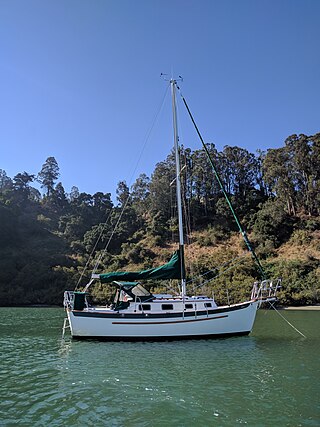Related Research Articles

The Bayfield 25 is a Canadian pocket cruiser sailboat, that was designed by Ted Gozzard and first built in 1975.

The Bayfield 30/32 is a Canadian sailboat, that was designed by Ted Gozzard as a cruising boat and first built in 1973.

The Dana 24 is an American trailerable sailboat that was designed by William Crealock as an ocean cruiser and first built in 1974.
The Island Packet 35 is an American sailboat that was designed by Robert K. Johnson as a cruiser and first built in 1988.
The Watkins 36, also known as the W36 and W36AC, is an American sailboat that was designed by William H. Tripp Jr and the Watkins brothers, first built in 1981.
The Watkins 36C, also known as the W36C, is an American sailboat that was designed by William H. Tripp Jr and the Watkins brothers. It was first built in 1981.
The Niagara 35 is a Canadian sailboat that was designed by Mark Ellis as a cruiser and first built in 1978.
The Seidelmann 37 is an American sailboat that was designed by Bob Seidelmann as a racer-cruiser and first built in 1980.
The Endeavour 37 is an American sailboat that was designed by Dennis Robbins as racer-cruiser and first built in 1977.
The Corbin 39 is a Canadian sailboat that was designed by Robert Dufour and Marius Corbin as a global circumnavigation cruiser and first built in 1979.
The Islander 40 is an American sailboat that was designed by Doug Peterson as a racer-cruiser and first built in 1979.
The Dickerson 41 is an American sailboat that was designed by Ernest Tucker as a cruiser and first built in 1973.
The Lord Nelson 41 is an American sailboat that was designed by Loren Hart as a cruiser and first built in 1982.
The Nimbus 42 is a Swedish sailboat that was designed by Americans F. Michael Kaufman and Robert Ladd as a cruiser-racer and first built in 1981.
The Irwin 41 is an American sailboat that was designed by Ted Irwin as a cruiser and first built in 1982.
The Caliber 40 is an American sailboat that was designed by Michael McCreary as a cruiser and first built in 1992.
The Bayfield 40 is a Canadian sailboat that was designed by Ted Gozzard for cruising and first built in 1982.
Bayfield Boat Yard Limited was a Canadian boat builder originally based in Bayfield, Ontario, and later in nearby Clinton, Ontario. The company specialized in the design and manufacture of fibreglass sailboats. The company was founded by Ted Gozzard in 1970 and continued in business until a plant fire forced its closure in 1988.
The Bayfield 29 is a Canadian sailboat that was designed by Ted Gozzard as a cruiser and first built in 1978.

The Beneteau First Class 10 is a French sailboat that was designed by Jean Marie Finot of Groupe Finot and Jacques Fauroux as a racer/cruiser and first built in 1982.
References
- 1 2 3 4 5 6 7 McArthur, Bruce (2020). "Bayfield 36 sailboat". sailboatdata.com. Archived from the original on 30 May 2020. Retrieved 30 May 2020.
- 1 2 Donaldson, Sven (June 1987). "Bayfield 36". Canadian Yachting . Archived from the original on 18 October 2018. Retrieved 26 May 2020.
- 1 2 Jordan, Richard (27 December 2009). "Bayfield 36 Review: Classic Marathon Runner". Jordan Yachts. Archived from the original on 4 May 2019. Retrieved 15 May 2020.
- ↑ McArthur, Bruce (2020). "Bayfield Boat Yard Ltd. (CAN)". sailboatdata.com. Archived from the original on 26 May 2020. Retrieved 30 May 2020.
- 1 2 3 Bayfield Boat Yard (1984). "Bayfield 36" (PDF). jordanyachts.com. Archived (PDF) from the original on 12 August 2016. Retrieved 30 May 2020.